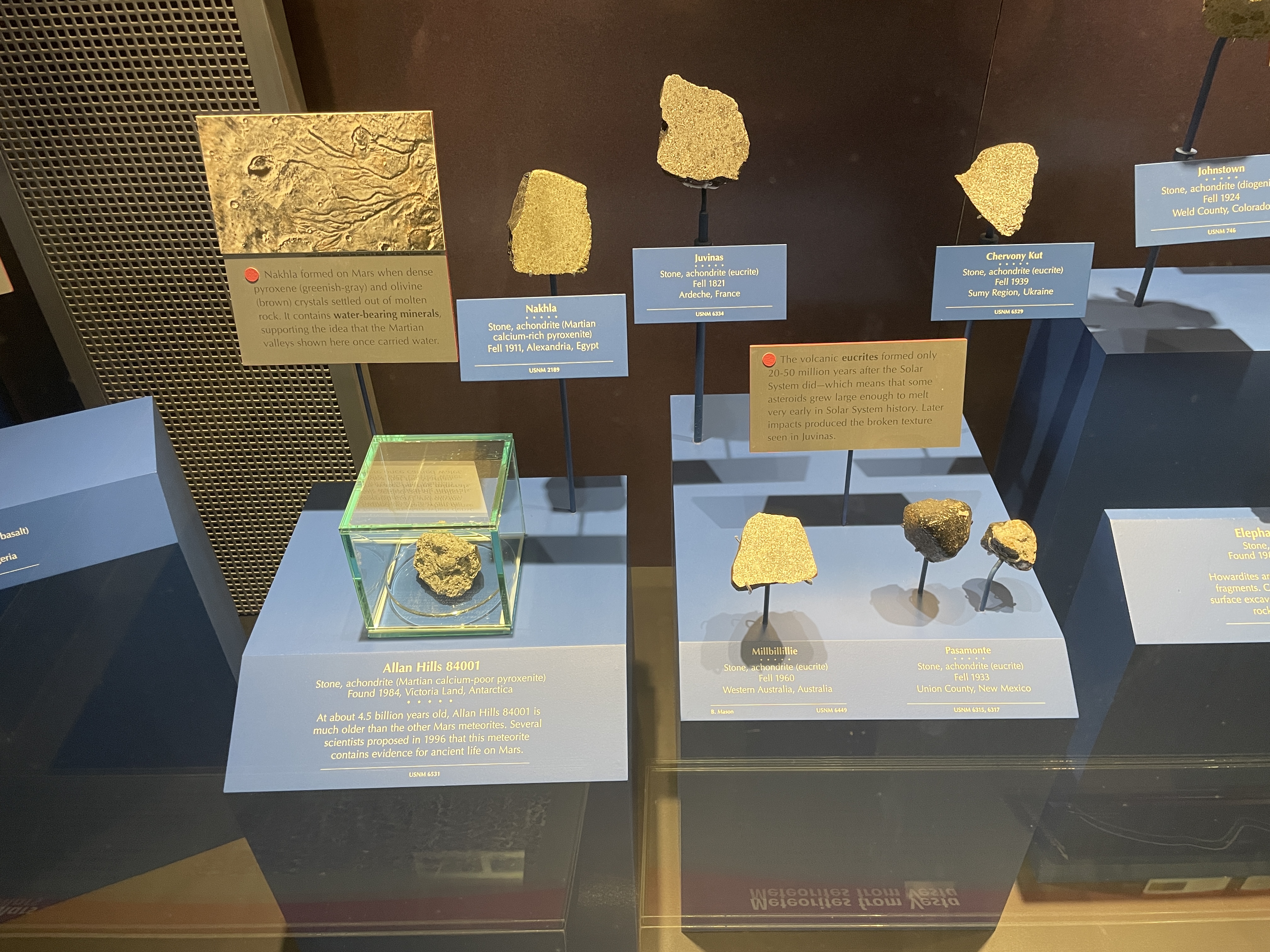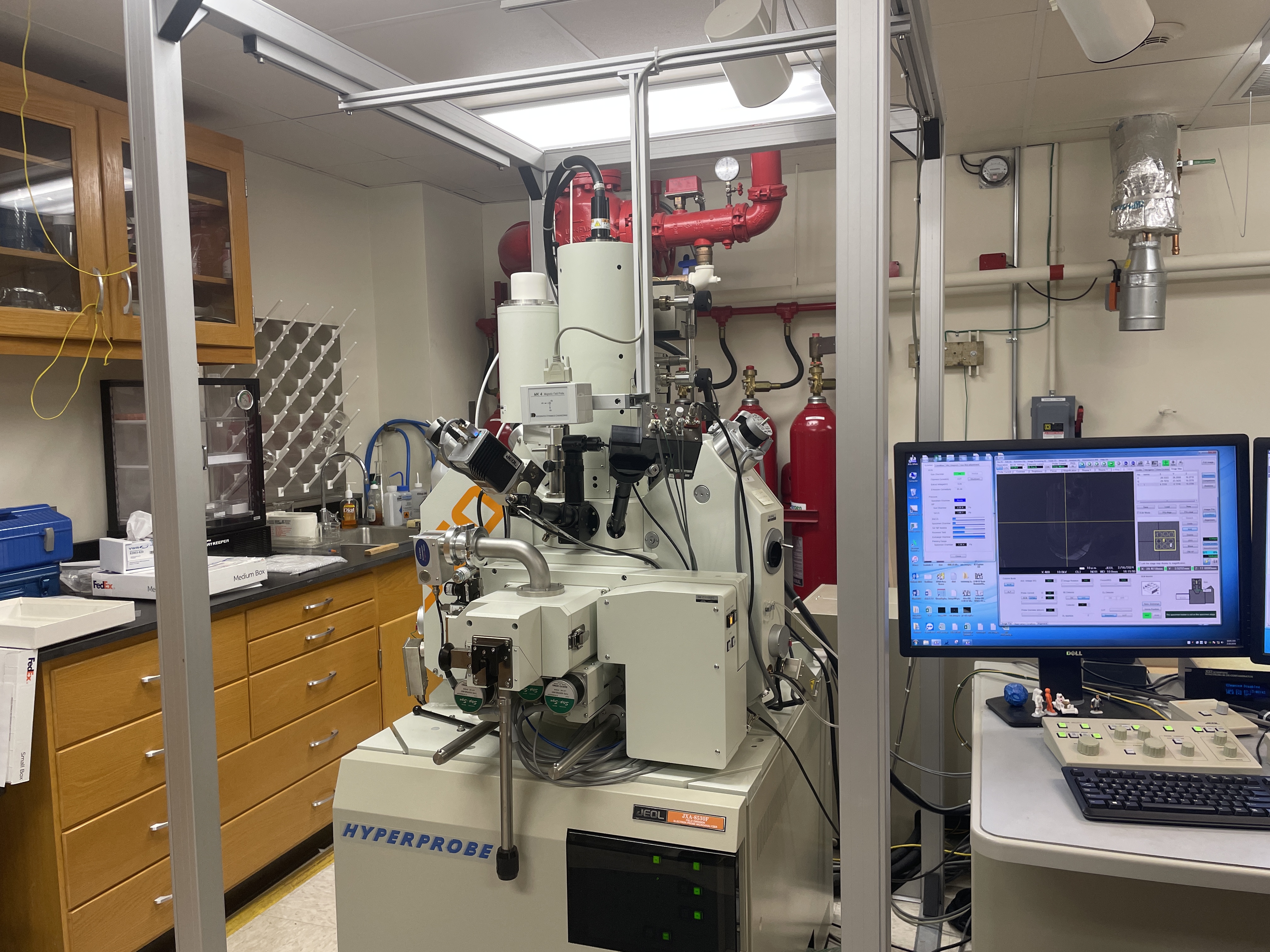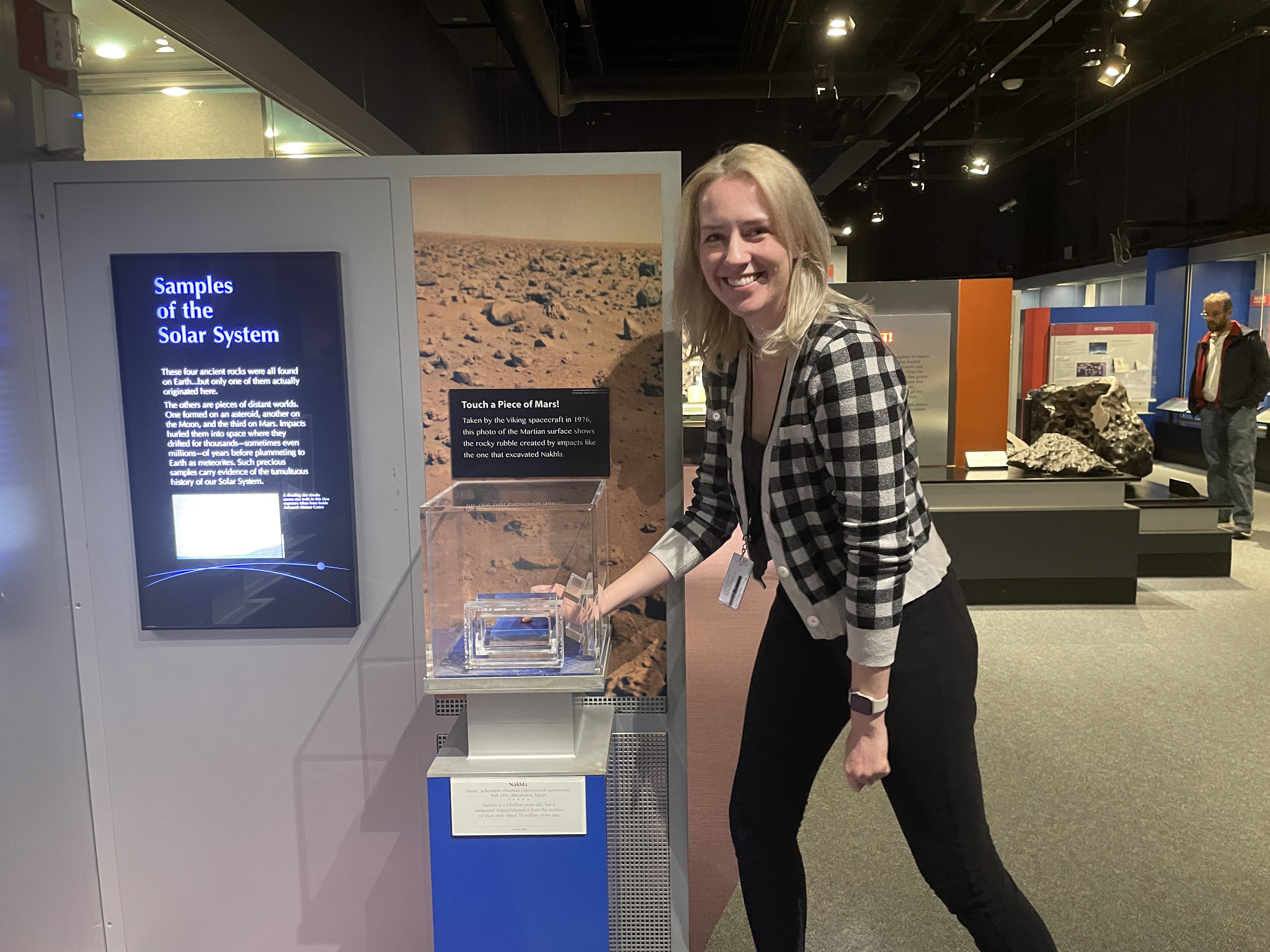NATIONAL MUSEUM OF NATURAL HISTORY
Mars Madness: Meet the Scientist Studying the Rocky Surface of Mars
Planetary geologist Amanda Ostwald studies Martian meteorites to understand what makes Mars different from — and similar to — planet Earth
:focal(2015x1334:2016x1335)/https://tf-cmsv2-smithsonianmag-media.s3.amazonaws.com/filer_public/6d/17/6d17bbd3-c8db-4cba-8a41-5ecfdc24ac83/meteor_crater.jpg)
Humans have always been fascinated by Mars. The “Red Planet” is one of our closest cosmic neighbors and the easiest planet to spot in Earth’s night sky. But historically, our understanding of Mars has been formed more by culture and fiction than rock-solid science.
Now, scientists like Amanda Ostwald, a planetary geologist and Peter Buck postdoctoral fellow at the National Museum of Natural History, have the samples and the tools to learn what the surface of Mars is actually like. Ostwald studies Martian meteorites, which are rocks that are ejected from the surface of Mars, pass through the Earth’s atmosphere, and end up on the ground before making their way to her laboratory. As a planetary igneous petrologist, Ostwald specializes in the subset of meteorites that are solidified from molten magma. She focuses primarily on “young” meteorites that formed around 1 billion years ago and uses high-tech tools like the electron microprobe to study the properties of these Martian rocks.
According to Ostwald, studying rocks from Mars can even broaden our understanding of past and present life on Earth and shed light on what makes our planet unique.

Last year, Ostwald earned her Ph.D. from the University of Nevada, Las Vegas. She is now embarking on a new journey at the Smithsonian to learn more about the surface of Mars.
For this month’s installment of “Meet a SI-entist,” Smithsonian Voices spoke with Ostwald to learn about her path to planetary geology, why it’s so important to study Mars and what this knowledge could mean for the future.
What does it mean to be an igneous petrologist, and what is it like to work in the Mineral Sciences Department at the Smithsonian?
I study igneous rocks, which are rocks formed by magma and lava. We call magmatic meteorites achondrites. Martian achondrites sat out on the surface of Mars, another meteor came, struck the surface, and then ejected that igneous rock to earth. And then those rocks make their way to our labs!
I’m the only igneous petrologist currently specializing in Mars in the Mineral Sciences department. Getting to work with other people who study metallic meteorites, or chondrites — ones that didn’t melt — is fun, it’s a neat perspective. My research is about finding out how long meteorites might have sat in magma chambers before they erupted. In my dissertation, I identify evidence that magmas on Mars are much like those on Earth and are stored for long periods of time.
What is exciting about working at the Smithsonian is that the folks here do meteorite identification right from the start. I’ve usually come in at the end of a meteorite’s story: the only way I knew that it came from Mars was because someone else identified it for me.
/https://tf-cmsv2-smithsonianmag-media.s3.amazonaws.com/filer_public/d6/df/d6dff90e-52b9-4919-a492-458d7fb0bcab/meteorite_thin_section.jpg)
Let’s say you have a rock in your hand. How can you tell whether it is a meteorite from Mars? What kinds of information are you looking for once you know that it is?
You can identify meteorites by what’s called a fusion crust. As a meteorite enters the Earth’s atmosphere, there’s a lot of friction in the atmosphere and it melts it a little bit. That will form a glassy shell around it. It also has these thumb hole shapes, called regmaglypts, on the shell that are easily recognizable.
Martian meteorites are difficult to identify beyond that because they look so much like earth rocks. You really have to do chemistry on them to get an idea for where they came from. By comparing the chemical isotopes of oxygen, and the ratio of iron to manganese, we can identify exactly which planet it came from.
We can also cut it open to examine the inside. We look for specific textures to see what type of meteorite it is. Once we get an idea for what it might be, we cut it up super thin and we mount it to a glass slide. We can look at it with a visual light microscope, a scanning electron microscope, or even an electron microprobe analyzer, to get even finer-grain details.

What does studying Martian meteorites teach us about not only Mars itself, but also Earth?
If we want to learn more about Earth’s deep past, Mars is the place to go. It’s our closest neighbor, and it’s the easiest to access.
The surface of Mars is really special in our solar system because it is ancient and in part because it doesn’t have plate tectonics or much active weathering. That means the surface of the planet hasn’t been drastically changed like it has been on Earth. So, there isn’t anything to obscure the information about how the planet first formed and how it evolved over their early history. This makes current-day Mars a good analog for early-Earth processes.
If Mars was habitable, we should have a record that’s not obscured by plate tectonics and weathering. That's why we send rovers to places where we think water was on ancient Mars, so we can look for those biosignatures.
Do you think we will find evidence of life on Mars? If so, what would that look like?
We actually thought we found evidence for life in a Martian meteorite once named Allan Hills 84001. It was one of the Antarctic meteorites that was curated by this department. When the meteorite was first analyzed by scientists at NASA Johnson Space Center, they thought the structure of some of the minerals could be evidence for bacterial life on early Mars.
"If we want to learn more about Earth’s deep past, Mars is the place to go." — Amanda Ostwald, planetary geologist
But since then, we’ve realized through more concrete analyses and longer-term, experimental studies that we can actually generate that kind of mineral structure without bacteria. It’s just Occam's razor: if we don’t have to evoke life to make it happen, we shouldn’t evoke life.
Honestly, I think it would be very hard to determine whether we have any real biosignatures, even on return samples from [the rover] Perseverance. Any life that existed 3 billion years ago would likely just be bacterial, and you don’t build up fossils of bacteria very easily.
That doesn't mean that it’s impossible, and there are lots of things we can look at – isotopic signatures and the like — that can help determine whether life might have been there. But I don’t think that we can be certain until we have samples in hand, and I don’t think we can know from meteorites alone.

Igneous petrology sounds like such a fascinating field, but it’s not a common career choice. How did you get into studying the surface of mars?
I just slowly fell in love with it. I went to university to study art and put off my science requirement until senior year. I took an astronomy class because everything else was full. I thought I was going to fail and ended up falling in love with it. And I was so sold that I went back to school a second time and majored in geology. I was like, “I have to do this for a living.”
I started by doing remote sensing work, which is basically using cameras to look at planets. I used rover cameras to build 3D models of the material the Curiosity rover was looking at. And I did an internship at the Johnson Space Center, and I was a student member of the Perseverance team for 2 years. From there the next thing was working with actual Mars samples. So that’s how I ended up in meteorites!
Since you’re still early in your career, what is your hope for the future of the field?
Actual return samples would be great. I think the biggest restriction on any interpretations we make with our research is just that we don’t know where the samples come from. We also aren’t working with a lot — all the Martian meteorites we have in the collection only total like the mass of a motorcycle.
Right now, the Perseverance rover is collecting great samples that are perfect for reconstructing Mars’s geologic history and spatial context, which we don’t get with meteorites.
/https://tf-cmsv2-smithsonianmag-media.s3.amazonaws.com/filer_public/7d/22/7d2235d6-1ee0-4452-b6ed-0c03a46a3d46/jpl.jpg)
If we can obtain actual return samples, it would change the way we can do Martian geology. We could get crater counting age dates on the full surface of Mars.
There have been a few successful return sample missions, including OSIRIS-REx to Bennu. Our museum was the first in the world to have Bennu on display! Missions like that encourage us to push even harder to get samples from larger planets.
And I think in my lifetime, getting return samples from Mars and different planetary bodies is a very strong likelihood. It’s the number one goal of a lot of the planetary science community right now.
This interview has been edited for length and clarity.
Meet a SI-entist: The Smithsonian is so much more than its world-renowned exhibits and artifacts. It is a hub of scientific exploration for hundreds of researchers from around the world. Once a month, we’ll introduce you to a Smithsonian Institution scientist (or SI-entist) and the fascinating work they do behind the scenes at the National Museum of Natural History
Related Stories
Meet the Smithsonian Scientist Venturing to Volcanoes to Understand the Origins of Earth’s Surface
Get to Know the Geologist Collecting Antarctic Meteorites
NMNH in Review: How an Asteroid Sample Traveled From Outer Space to the Museum’s Mineral Hall
How NASA Captured Asteroid Dust to Find the Origins of Life

